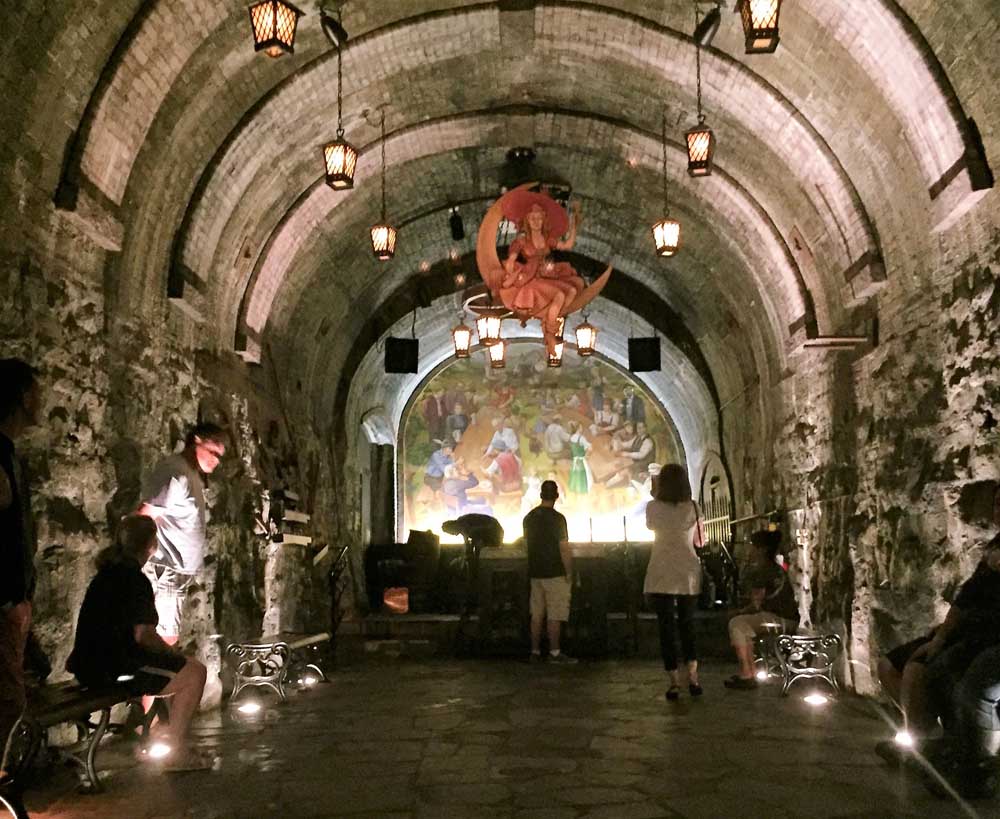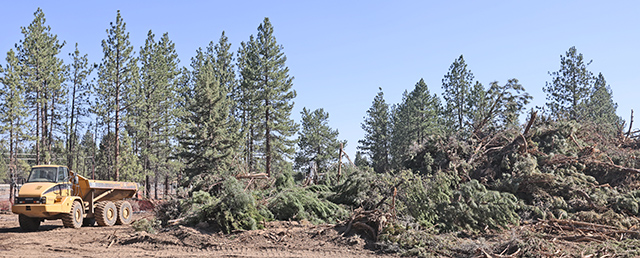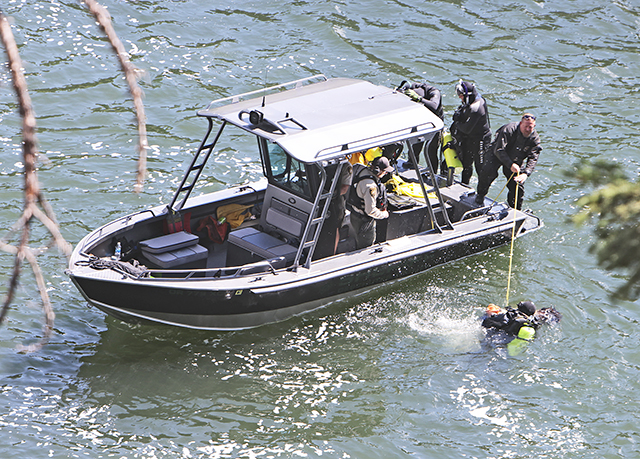Milwaukee: It’s all about the beer
Published 12:02 am Sunday, February 5, 2017

- The iconic Miller High Life “Girl in the Moon” welcomes visitors to a mid-19th-century cave at the MillerCoors brewery. Founder Fredrick Miller appears in the cave in a holographic image to relate his company’s history to tourists. (John Gottberg Anderson/Photos for The Bulletin)
MILWAUKEE — The Green Bay Packers won’t be playing in the Super Bowl this afternoon. But don’t think for a moment that Wisconsin beers won’t be well represented at the championship of professional football.
With apologies to Bend and Portland, Milwaukee — Wisconsin’s largest city, with a metropolitan population of 1.5 million — considers itself to be “the brewing capital of the world.” Milwaukee is well-known as the home of the Miller, Pabst, Schlitz and Blatz brewing companies, each of them established (along with more than 30 others) by German immigrants in the mid-1800s. Even its Major League Baseball team is named the Milwaukee Brewers.
Trending
Indeed, Miller (now MillerCoors) and Pabst Brewing (incorporating Schlitz and Blatz) are the second- and third-largest brewing companies, by production, in the United States, trailing only St. Louis-based Anheuser-Busch. Gridiron fans will no doubt see plenty of televised commercials from them this afternoon.
Of course, watching beer ads does not contribute to one’s enjoyment of beer. And there’s no better way to enjoy a beer than at its place of production. It was with this in mind that I visited the Lake Michigan shoreline city, 90 miles north of Chicago, to see what all the buzz is about.
Local flavor
I’m old enough to remember the slogan that promoted Schlitz, a company taken over by Pabst in 1999. Schlitz called itself “the beer that made Milwaukee famous,” as indeed it was following the great Chicago fire of 1871, when it doubled sales to its crippled urban neighbor.
The old brewery campus is now an upscale business community called Schlitz Park. It incorporates public areas along the 3-mile Milwaukee RiverWalk, a pedestrian walkway along the stream that once provided the breweries’ water. Facing Brewhouse Square, its Stock-House building — originally a bottling plant — is home to the Brown Bottle restaurant: When it opened as a tavern in 1938, it was a meeting place for Schlitz visitors after brewery tours.
MillerCoors has not abandoned its enormous original home in more than a century and a half. Its 79 buildings spread across 82 acres produce 500 cases of beer a day. But the free one-hour tours that begin and end in the Miller Brewery Visitor Center are so rote, they lack any sort of personal touch.
Trending
A film that traces company history, beginning with founder Fredrick Miller’s arrival in Milwaukee in 1855, is followed by a steep stair climb to the high-tech production facilities. It continues through the packaging center, distribution warehouse and historic Miller Caves, where Mr. Miller talks to visitors via holographic image. Beer is served, of course, at the end of the tour.
Lakefront Brewery craft beers are much more approachable, and similarly, the brewery tour is much more personable. Although the tours have become a local attraction, group sizes are kept small, as they are led by local actors and stand-up comedians hired specifically for the job.
Lakefront was founded in 1987 by brothers Jim and Russ Klisch, whose grandfather once drove a truck for Schlitz. Thirty years later, Russ Klisch remains as brewmaster. “I’m amazed what we’ve been able to accomplish here,” he told me.
The brewery produced the first Wisconsin ale since Prohibition. It was the first brewery in the United States to be certified organic, in 1996. It was the first in the state to be approved to label gluten-free beers. It was the first to be certified kosher, which has enabled it to sell in Israel as well as 37 states. It was the first to age organic barley wine in brandy barrels. “We’ve been an innovator,” Klisch understated.
Lakefront stands on the Milwaukee River at the foot of Brewers Hill, a neighborhood so named because many original residents were brewery workers. It occupies the former home of the Milwaukee Electric Railway and Light Company, a coal-fired power plant that kept the city’s streetcars running, and is built of Cream City brick, a light ochre-colored clay stone that was widely used in Milwaukee in the 19th century. Even today, many of the buildings on Brewers Hill and in the downtown area carry its distinctive color.
Sprecher Brewery was established before Lakefront, in 1985, as Milwaukee’s first craft brewery since Prohibition. But I didn’t enjoy its tour as much as its competitor — perhaps because it puts more emphasis on producing soft drinks than beer. Although its Black Bavarian “schwarzbier” is excellent, this small company brews more gourmet root beer than all of its alcoholic beers combined. And that lures unruly, sugar-addled children onto tours with their parents.
Blue-ribbon Pabst
The brewing giant that truly engaged me was Pabst. In fact, I slept above the copper brewing kettles in the original 1844 brewery complex, which did not close until 1997. The 90-room Brewhouse Inn & Suites opened in its place in 2013, an impressive work of historic revitalization that saw the conversion of two huge buildings on a low hill above downtown.
The design integrates many of the structures’ original features, including a large stained-glass window that depicts King Gambrinus, a folkloric patron of beer whose legend may have originated in what is today Belgium. There are winding staircases and a large skylight above those kettles, which date back to the 1890s. And the front desk is made from more than 1,500 beer bottles: Contractors were given a case of beer each week and asked to return the empty bottles to build the desk.
On an opposite block, the 1880 corporate headquarters is now Best Place at the Historic Pabst Brewery. A beer history tour beginning here includes vintage TV commercials, a tavern and banquet hall, a gift shop and a walk-through of Captain Frederick Pabst’s original office. Well over a century ago, the captain invested in 400,000 yards of blue silk ribbon as thank-you gifts for those who took his free brewery tour.
By the 1890s, his premium beer, Pabst Blue Ribbon (PBR), had helped make the company the world’s largest production brewery, a position it held into the 1960s — even through Prohibition.
As a young man, Frederick Pabst had been the captain of a Lake Michigan steamer. But he made his fortune after he married another local brewer’s daughter and was taken into partnership in the family business. His wealth remains on display today at the Pabst Mansion, a Flemish Renaissance Revival-style mansion completed in 1892 in Milwaukee’s Avenues West neighborhood.
As a philanthropist and patron of the arts, Pabst saw that his home was adorned with the finest decorative art of the time. Considered the finest of the city’s Grand Avenue mansions, it represented the epitome of Gilded Age splendor in Milwaukee, and high society was often gathered beneath the crystal chandelier in the dining room, or beside the remarkable woodwork of the grand master staircase.
After Pabst’s death, the house passed to the Archdiocese of Milwaukee, which owned it from 1908 to 1975. Five archbishops and many priests and sisters appreciated its proximity to Marquette University, whose campus is just east of here. Finally, the house was purchased by a historic preservation group, which opened it for public tours.
Wait, there’s more
There’s more to Milwaukee than beer, of course. But some might say beer goes hand-in-mug with motorcycle riding — a pursuit that is inextricably tied to the Harley-Davidson Motor Co., founded in Milwaukee in 1903.
A visit to the Harley-Davidson Museum fascinates even the nonbiker. More than 450 motorcycles of various styles are displayed in this $75 million, three-building complex sprawling across 20 acres. Ten bikes invite visitors to pose for photos. Other exhibits include an engine room, an interactive design room and Harley’s influence on American pop culture. A section on company history includes the oldest known Harley-Davidson in existence encased in glass.
More classically conceived is the Milwaukee Art Museum on the shore of Lake Michigan. Not only is it one of the largest art museums in the United States, with more than 35,000 works in its permanent collection; its architecture is among the most stunning as well.
Its three buildings are highlighted by the Quadracci Pavilion, created in 2001 by Spain’s Santiago Calatrava. Better known as a bridge architect, Calatrava crowned the building’s entrance with a brise soleil (sun break) that opens like butterfly’s wings by day and folds over the tail at night or in inclement weather. Its 217-foot wingspan is greater than most Boeing 747s.
Although Georgia O’Keeffe is most often identified with the New Mexico desert, she was a Wisconsin native, and this museum has a large collection of her work. There are fine exhibits of antiquities, folk art and (surprisingly) Haitian art, along with European and American works: Featured artists include Rodin, Degas, Monet, Toulouse-Lautrec, Picasso, Rothko, Frank Lloyd Wright and Andy Warhol.
Warhol no doubt would have found something to paint at the Milwaukee Public Market, even though Campbell’s Soup cans may be few and far between. Located in the city’s historic Third Ward, once a hub for grocery brokers, the market focuses on local products, from artisan cheeses to homemade chocolates. There’s a demonstration kitchen here and a variety of small cafes serving everything from Mexican to Japanese to Middle Eastern food.
If there’s one food for which Wisconsin is famous, it’s German-style sausage. At Usinger’s Famous Sausage, on Old World Third Street, more than 75 varieties are available, from bratwurst and kielbasa to braunschweiger. Fritz Usinger, the company’s fourth-generation owner (it was established in 1880), offers generous meat-and-cheese plates with flights of local beers in his store, which maintains a yesteryear charm.
Also on Old World Third Street are a variety of other beer halls and brat houses, as well as the Wisconsin Cheese Mart. Stroll west to the Milwaukee River and look for a statue of Arthur Fonzarelli, “The Fonz,” as played by actor Henry Winkler in the popular ’70s and ’80s sitcom “Happy Days.”
Not far from here is a top-secret oasis of international espionage, a hideout for wannabe spies. Behind a discreet alley door marked “International Exports, Ltd.,” is SafeHouse, one of the most unusual cocktail lounges you’re ever likely to encounter. You won’t be admitted without a password (an interrogation at the front entrance may prompt you). Thematically consistent throughout, SafeHouse has been around since the peak of the Cold War in the mid-1960s. Inside, there are two-way mirrors, spy holes, secret passages and more.
Outstanding meals
I enjoyed three truly outstanding dinners in Milwaukee.
At Braise, in the Walker’s Point district south of downtown, chef-owner Dave Swanson is committed to sustainability: Eight years ago, he created the nation’s first Restaurant Supported Agriculture program. He works directly with farmers and craft purveyors in designing his menu; maintains a rooftop garden for his own herbs and vegetables; offers cooking classes and a subscription-based home food delivery program; and encourages diners to share common tables. My beef tongue taco with cumin-pickled beets, accompanied by a cabbage-and-rutabaga salad, were wonderful surprises.
At Bartolotta’s Lake Park Bistro, overlooking Lake Michigan on the city’s east side, my “Loup de Mer en Papillote” — Mediterranean sea bass, baked in parchment with mussels, shrimp, fingerling potatoes, broccolini and lemon — was the centerpiece of an outstanding meal of French country cuisine.
And at Sanford Restaurant, a small but classy spot in the residential Brady Street neighborhood, chef-owner Justin Aprahamian offered his “surprise tasting menu,” featuring chargrilled morel mushrooms with fiddleheads, roasted octopus in Mexican mole sauce, and a macadamia nut tart with coconut ice cream.
My breakfasts included avocado toast, with poached eggs and sprouted rye, at the Café at the Plaza Hotel; hash browns stuffed with chicken chorizo at Blue’s Egg, off Interstate 94 on Milwaukee’s west side; and “I’ll Have What She’s Having” — eggs Benedict with mushrooms and potato latkes — at Wolf Peach, on Brewers Hill.
My favorite spot for an after-dinner drink was Bryant’s Cocktail Lounge, established in 1938 and said to be Milwaukee’s oldest. I had a classic Vieux Carré while cozied up to the bar between plush velvet walls and among year-round Christmas lights. Bryant’s felt like the sort of place one might go for a discreet rendezvous, in a part of town where one might not be recognized.
But I’ll bet they’ll be showing the Super Bowl today. And serving Wisconsin beer, as well.
— John Gottberg Anderson can be reached at janderson@bendbulletin.com.
If you go
(All addresses in Milwaukee, Wisconsin)
INFORMATION
Visit Milwaukee: 648 N. Plankinton Ave., Suite 220; visitmilwaukee.org, 414-273-3950, 800-554-1448.
HOTELS
Ambassador Hotel: 2308 W. Wisconsin Ave.; ambassadormilwaukee.com, 414-345-5000. Rates from $123
The Brewhouse Inn & Suites: 1215 N. 10th St.; brewhousesuites.com, 414-810-3350. Rates from $209
Knickerbocker on the Lake: 1028 E. Juneau Ave.; knickerbockeronthelake.com, 414-276-8500. Rates from $110
The Plaza Hotel: 1007 N. Cass St.; plazahotelmilwaukee.com, 414-276-2101. Rates from $119
RESTAURANTS AND BARS
Bartolotta’s Lake Park Bistro: 3133 E. Newberry Blvd.; lakeparkbistro.com, 414-962-6300. Lunch Monday to Friday, brunch Sunday, dinner every day. Expensive
Blue’s Egg: 317 N. 76th St.; bluesegg.com, 414-299-3180. Breakfast, lunch and brunch every day. Budget to moderate
Braise Restaurant & Culinary School: 1101 S. Second St.; braiselocalfood.com, 414-212-8843. Dinner Tuesday to Saturday. Moderate
The Brown Bottle: Schlitz Park, 221 W. Galena St.; brownbottlemke.com, 414-539-6450. Lunch Monday to Friday, dinner Monday to Saturday. Moderate
Bryant’s Cocktail Lounge: 1579 S. Ninth St.; bryantscocktaillounge.com, 414-383-2620. Cocktails Tuesday to Sunday.
Miller Time Pub & Grill: 509 W. Wisconsin Ave.; milwaukee.millertimepubandgrill. com, 414-273-8709. Lunch and dinner every day. Budget and moderate
Safe House: 779 N. Front St.; safe-house.com, 414-271-2007. Lunch and dinner every day. Budget and moderate
Sanford Restaurant: 1547 N. Jackson St.; sanfordrestaurant.com, 414-276-9608. Dinner Monday to Saturday. Expensive
Wolf Peach: 1818 N. Hubbard St.; wolf-peach.com, 414-374-8480. Brunch Saturday and Sunday, dinner nightly. Moderate
BREWERIES
Lakefront Brewery: 1872 N. Commerce St.; lakefrontbrewery.com, 414-372-8800.
Miller Brewery Visitor Center: 4251 W. State St.; millercoors.com, 414-931-2150.
Sprecher Brewery: 701 W. Glendale Ave.; sprecherbrewery.com, 414-964-7837.
ATTRACTIONS
Best Place at the Historic Pabst Brewery: 901 W. Juneau Ave.; bestplacemilwaukee.com, 262-893-3737.
Grohmann Museum: Milwaukee School of Engineering, 1000 N. Broadway St.; msoe.edu/museum, 414-277-2300.
Harley-Davidson Museum: 400 W. Canal St.; harley-davidson.com/museum, 414-287-2810.
Milwaukee Art Museum: 700 N. Art Museum Drive; mam.org, 414-224-3200.
Milwaukee Public Market: 400 N. Water St.; milwaukeepublicmarket.org, 414-336-1111.
Usinger’s Famous Sausage: Old World Third Street, 1030 N. Old World Third St.; usinger.com, 414-276-9100.
Pabst Mansion: 2000 W. Wisconsin Ave.; pabstmansion.com, 414-931-0808.






